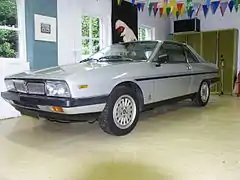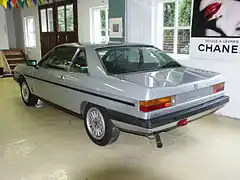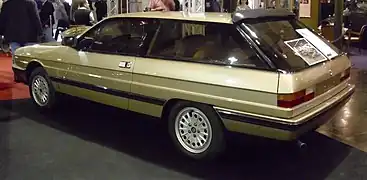| Lancia Gamma | |
|---|---|
_(cropped).jpg.webp) Lancia Gamma Coupe | |
| Overview | |
| Manufacturer | Lancia |
| Production | 1976-1984 |
| Designer | Pininfarina (saloon) Aldo Brovarone at Pininfarina (coupé)[1] |
| Body and chassis | |
| Class | Executive car (E) |
| Body style | |
| Layout | Front-engine, front-wheel-drive |
| Related | Lancia Beta[1] Lancia 2000 |
| Powertrain | |
| Engine |
|
| Transmission | |
| Dimensions | |
| Wheelbase | 2,670 mm (105.1 in) - berlina 2,555 mm (100.6 in) - coupé[2] |
| Length | 4,580 mm (180.3 in) - berlina 4,485 mm (176.6 in) - coupé[2] |
| Width | 1,730 mm (68.1 in)[2] |
| Height | 1,410 mm (55.5 in) - berlina 1,330 mm (52.4 in) - coupé[2] |
| Curb weight | 1,320 kg (2,910 lb) - berlina 1,290 kg (2,844 lb) - coupé[1] |
| Chronology | |
| Predecessor | Lancia 2000 Lancia Flaminia |
| Successor | Lancia Thema |
.jpg.webp)
The Lancia Gamma (Tipo 830) is an executive car (E-segment in Europe) manufactured and marketed by the Lancia subdivision of Fiat. Following its debut at the 1976 Geneva Motor Show[1] as Lancia's new flagship, the Gamma was marketed as 4-door fastback saloon as the Berlina (1976-1984) and as 2-door coupé (1977-1984), both designed by Pininfarina — with 15,272 and 6,790 manufactured, respectively.[3] The Gamma superseded the Lancia Flavia.
The fastback style of the Berlina featured a conventional boot at the rear, rather than a hatchback. At the car's press launch Pininfarina said a hatchback was avoided to save the inconvenience to back seat passengers when luggage is loaded, ostensibly draughts.[4]
The name
Gamma is the third letter of the Greek alphabet. Lancia had used Greek letters to denote its models before 1945, and the nomenclature was revived with the Lancia Beta in 1971, the first Lancia developed under Fiat supervision. The Gamma is also shared front-wheel drive and suspension elements from the Beta.[1] The Gamma carries the γ (lower case gamma) emblem both inside and out.
Models
 Lancia Gamma Coupe (front).
Lancia Gamma Coupe (front). Lancia Gamma Coupe (rear).
Lancia Gamma Coupe (rear). Lancia Gamma Berlina (front).
Lancia Gamma Berlina (front)..jpg.webp) Lancia Gamma Berlina (rear).
Lancia Gamma Berlina (rear).
Engines

The Lancia Gamma was a front-wheel drive car with longitudinally-mounted boxer engine and with either a 5-speed manual transmission and later a 4-speed automatic transmission.[1] The Gamma received a midcycle face-lift, receiving Bosch L-Jetronic fuel injection as well as a new corporate grille, 15-inch "sunburst" alloy wheels, and a revised interior with new instrumentation, interior lighting, badging, handbrake and gear lever gaiter.
Though Fiat had planned to use one of their V6 engines, Lancia developed unique flat-4 engines for the Gamma. The Lancia Flavia and Flavia Coupe had used 1.8 and 2.0 litre flat four engines and the Lancia 2000 used the 2.0 litre engine. Engine designer De Virgilio also drew up an engine for the Gamma which was a V6 4-cam with either 3- or 4-litre displacement, but this never came to fruition.
The flat engine, though large for a modern 4-cylinder petrol engine, lacked the cachet associated with six and eight cylinder engines but enabled Pininfarina chief stylist Aldo Brovarone to lower the coupé's bonnet line and to steeply rake its windscreen.
Pressure cast in alloy with wet cylinder liners, the engine was light and though it only produced 140 bhp (104 kW), (120 bhp (89 kW) in 2.0-litre form) its torque was available at just 2000 rpm.
Initially available with a displacement of 2.5 L (Gamma 2500), it was later joined by a 2.0 L version (Gamma 2000), which resulted from the Italian tax system (cars with engines larger than 2.0 L were subject to heavier tax burden). The displacement was lowered by decreasing the bore rather than the stroke of the engine. Both displacements were using Weber carburetors, and the 2.5 L also came in a version fitted with fuel injection (Gamma 2500 I.E.)[1][2]
- 2.0 L carburetor 8v SOHC flat-4 - 1999 cc, 120 PS (1st series) 115 PS (2nd series) (85 kW)[2]
- 2.5 L carburetor 8v SOHC flat-4 - 2484 cc, 140 PS (103 kW)[2]
- 2.5 L I.E. 8v SOHC flat-4 - 2484 cc, 140 PS (103 kW)[2]
| Lancia Gamma Coupé production figures* | ||||||||||||||
|---|---|---|---|---|---|---|---|---|---|---|---|---|---|---|
| Series | 1976 | 1977 | 1978 | 1979 | 1980 | 1981 | 1982 | 1983 | 1984 | Totals | ||||
| 1 | 9 | 1,006 | 2,064 | 1,236 | 6,790 | |||||||||
| 2 | 37 | 1,225 | 952 | 176 | 51 | 33 | ||||||||
*stated by Pininfarina production records[3]
| Lancia Gamma Coupé version figures | ||||
|---|---|---|---|---|
| 2.0 | 2.5 | 2.5 ie | Total | |
| Series 1 1976-79 | 1,978 | 2,337 | 4,315 | |
| Series 2 1980-84 | 1,265 | 1,209 | 2,474 | |
| Total | 3,243 | 3,546 | 6,789 | |
Concepts
Several concepts were developed from the Gamma Platform over the years:[5]
- 1977 Pininfarina Gamma Spider — a targa top version of coupé.
- 1977 Italdesign Megagamma — a short-nosed MPV (multi-purpose vehicle) hatchback-bodied variant.
- 1980 Pininfarina Gamma Scala — a saloon, based on the coupé but with a regular notchback boot.[6]
- 1981 Saloon — a Berlina-based six-window three-box, notchback saloon variant designed by Centro Stile Lancia.
- 1982 Pininfarina Gamma Olgiata — a three-door shooting brake, based on the coupé; similar in concept to the Lancia Beta HPE.[7]
 1981 Saloon
1981 Saloon 1982 Pininfarina Gamma Olgiata.
1982 Pininfarina Gamma Olgiata.
References
- 1 2 3 4 5 6 7 8 "Lancia Gamma". The Lancia pages @ www.CarsFromItaly.com. Archived from the original on 2005-03-24. Retrieved 2006-08-03. (accessed via the Wayback Machine)
- 1 2 3 4 5 6 7 8 "Auto Katalog". Autokatalog Modelljahr. Motor Presse Stuttgart: 220–221. 1983. ISSN 0949-0884. - technical data based on 1982/83 models
- 1 2 "PRODUZIONE COMPLESSIVA" (PDF). pininfarina.it. Archived from the original (PDF) on 2011-06-05. Retrieved 2007-08-03.
- ↑ "Top of the Lancia gamut". Autocar. Vol. 144 nbr 4155. 26 June 1976. pp. 68–70.
- ↑ "Lancia Concept Cars @ www.CarsfromItaly.com". Carsfromitaly.net. Retrieved 2016-01-21.
- ↑ "Lancia Gamma Scala @ CarsfromItaly". Carsfromitaly.net. Retrieved 2016-01-21.
- ↑ "Lancia Gamma Olgiata @ CarsfromItaly". Carsfromitaly.net. Retrieved 2016-01-21.